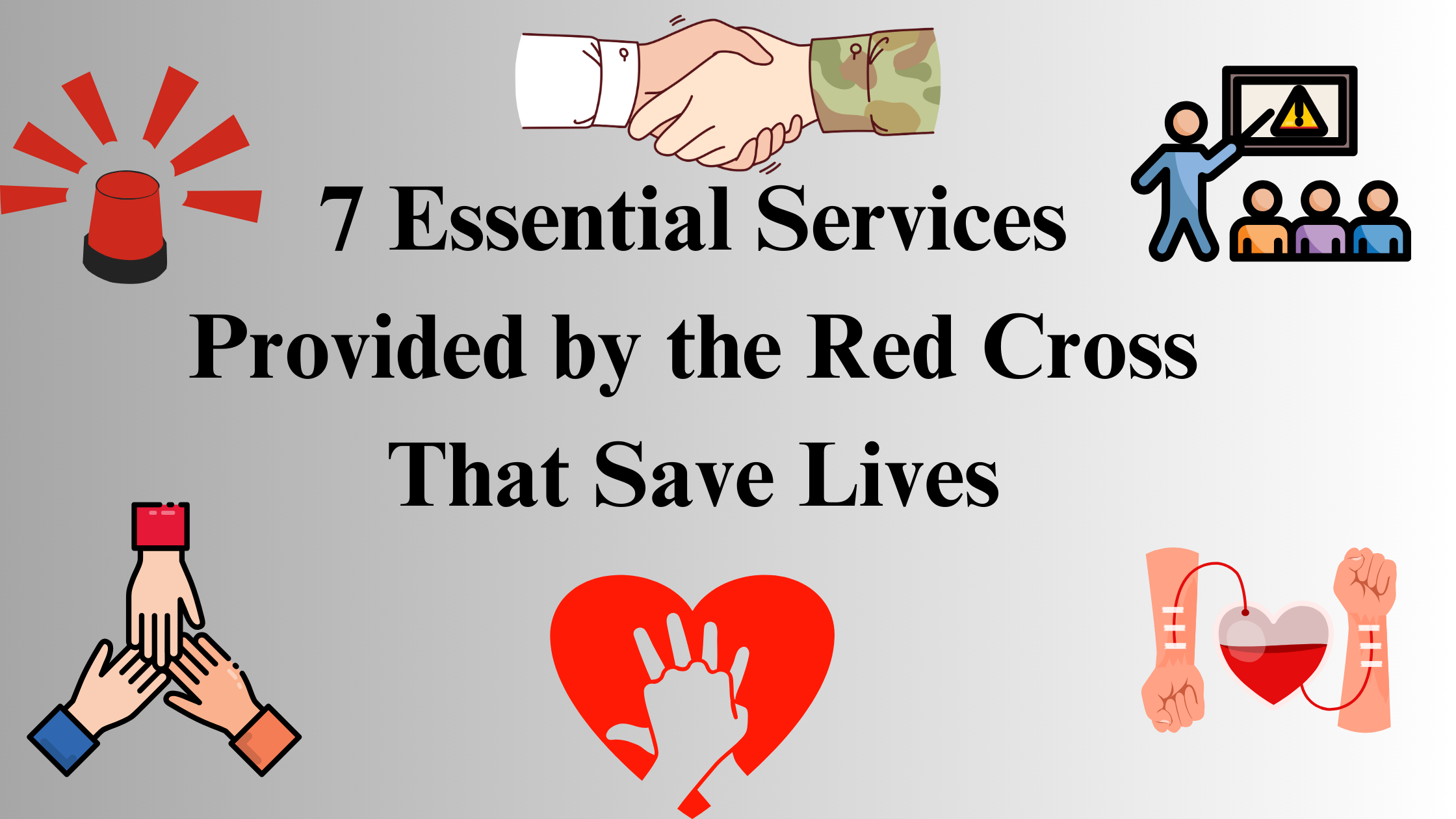The Red Cross is a vital organization that provides essential services to individuals and communities around the globe. Established in 1863, the Red Cross operates in nearly every country, focusing on humanitarian assistance, disaster relief, and health services.
Through its diverse programs, the Red Cross plays a crucial role in saving lives and supporting those in need.
In this article we will look into seven essential services provided by the Red Cross that have a significant impact on people’s lives.
7 Essential Services Provided by the Red Cross
1. Disaster Response and Relief
One of the most recognized services of the Red Cross is its disaster response and relief efforts. When natural disasters strike—such as hurricanes, floods, earthquakes, or wildfires—the Red Cross mobilizes quickly to provide immediate assistance to affected communities. This includes:
- Emergency Shelters: The Red Cross sets up emergency shelters to provide a safe haven for those displaced by disasters. These shelters offer food, water, and a place to rest.
- Disaster Recovery Assistance: After the immediate response, the Red Cross continues to support recovery efforts by providing financial assistance, helping individuals and families rebuild their homes, and offering emotional support through counseling services.
2. Blood Donation Services
The Red Cross is one of the largest suppliers of blood and blood products in the United States. The organization hosts numerous blood drives and operates blood donation centers to ensure a steady supply of blood for hospitals and patients in need. Key aspects of this service include:
- Life-Saving Transfusions: Blood donations are critical for surgeries, trauma care, cancer treatment, and managing chronic conditions. Each donation can save multiple lives, making it an essential service for healthcare.
- Community Engagement: The Red Cross actively promotes blood donation through community campaigns, encouraging individuals to donate and educate them about the importance of blood donations.
3. Health and Safety Training
The Red Cross offers a range of health and safety training courses that equip individuals with life-saving skills. These programs include:
- First Aid and CPR: The Red Cross provides comprehensive training in first aid and cardiopulmonary resuscitation (CPR), teaching participants how to respond effectively in emergencies, from minor injuries to life-threatening situations.
- Lifeguard and Swimming Instruction: The organization trains lifeguards to ensure safe aquatic environments, reducing the risk of drowning and accidents in pools and open water.
- Mental Health Support: The Red Cross recognizes the importance of mental health in emergency situations. They provide training for psychological first aid, teaching individuals how to support those in emotional distress during crises.
4. International Humanitarian Aid
The Red Cross operates on a global scale, providing humanitarian aid to communities affected by conflict, disaster, and health crises. Their international services focus on:
- Emergency Relief Operations: The Red Cross responds to crises worldwide, providing food, shelter, and medical care to those in need. They work alongside local organizations and governments to ensure effective assistance.
- Health Programs: The organization addresses health emergencies, such as outbreaks of disease (like Ebola or cholera) by providing vaccinations, healthcare services, and education to affected communities.
5. Support for Military Families
The Red Cross has a long-standing commitment to supporting military personnel and their families. Their services for military families include:
- Emergency Communication Services: The Red Cross helps service members connect with their families during emergencies, ensuring that they can communicate important information, especially during deployment.
- Financial Assistance: The organization provides financial support for military families facing unexpected hardships, such as travel costs for family emergencies or essential needs during deployment.
- Mental Health Resources: The Red Cross offers programs focused on the mental well-being of veterans and active-duty service members, including counseling and peer support.
6. Community Preparedness Programs
The Red Cross promotes disaster preparedness at the community level through education and training. Their initiatives aim to equip individuals with the knowledge and resources needed to respond effectively in emergencies. These programs include:
- Emergency Preparedness Workshops: The Red Cross conducts workshops that teach individuals and families how to create emergency plans, assemble disaster supply kits, and stay informed during crises.
- Youth Engagement Programs: The organization engages youth in preparedness activities, teaching them how to respond to emergencies and become advocates for safety in their schools and communities.
7. Advocacy for Vulnerable Populations
The Red Cross is dedicated to advocating for vulnerable populations, including refugees, migrants, and marginalized communities. Their advocacy work focuses on:
- Human Rights Initiatives: The Red Cross promotes respect for human rights and humanitarian law, ensuring that the needs of vulnerable individuals are met during conflicts and disasters.
- Programs for Refugees and Migrants: The organization provides support services for refugees and migrants, including legal assistance, healthcare, and integration programs that help them adapt to their new communities.
Conclusion
The Red Cross is an indispensable organization that provides a wide range of essential services that save lives and uplift communities.
Through disaster response, blood donation, health training, international humanitarian aid, military support, community preparedness, and advocacy for vulnerable populations, the Red Cross addresses critical needs and promotes resilience in the face of adversity.
Their work not only saves lives but also fosters hope and recovery in the aftermath of disasters and crises.
By continuing to support the Red Cross, individuals can contribute to these life-saving efforts and help make a positive impact on the lives of countless people around the world.



